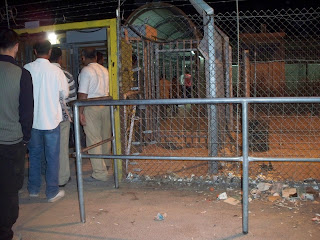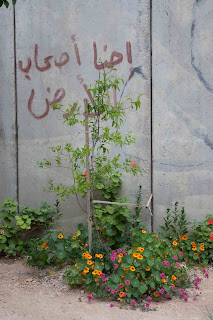
This is a time when two different national events are happening here: Israel’s ‘independence day’ and Palestine’s Nakbah: the first, a cause of celebration, the second, of mourning. The two dates are days apart, and the events they commemorate took place in this land sixty-one years ago. How do visitors make sense of such an apparent contradiction?
ALTERNATIVE TOURISM
'Palestine and Palestinians' is what it says it is: ‘more than an ordinary tourist guidebook’. It gives art, archaeology, religion and history: but it gives politics, too. In starting to read about the region some months ago, this is where, for instance, I first got some idea of what the ‘Nakbah’ means: the catastrophe for Palestine that was war launched by Israel on 4 April 1948, when thousands became refugees and hundreds were massacred - culminating in Israel’s declaration as an independent state on 14 May the same year. The Alternative Tourism Group who published it, was founded in 1995 and runs a ‘critical and experiential programme’ of guided tours round Palestine and Israel. (1). In the first month of being here, I have come to realize that alternative tourism is a growing industry.
Well-known by now for its passionate and active campaigns against the demolitions of Palestinian homes, the Israeli Campaign Against House Demolitions (ICAHD) in 2008 developed its own programme of tours of Israel-Palestine. (2) To many, Jerusalem is the holy city, a place of pilgrimage. In March, our group spent half a day with Angela Godfrey-Goldstein of ICAHD as our guide to its more secular reality: the huge development of Israeli settlements outside it. The biggest of these, built in 1976, is Ma’ale Admumim. Today, some 30,000 Israelis live there. The rows and rows of vast white apartment blocks felt a shock to the eyes after the stone of the old city. Angela’s seminar on the changing map of settlements like this took place against this backdrop. We were tourists all right – coach and cameras to prove it – but this was a different kind of tour.
To Abu Hassan, a former journalist now running his own alternative tourism business, the correct word for ‘settlements’ is ‘colonies’. Choosing to spend two of my days off in Jerusalem a month after seeing Ma’ale Admumim, I picked his trip to Hebron to find out more. With five others in a minibus it was another half-day of reading the landscape, this time south of Jerusalem. It’s just twenty miles door to door but as Hassan told us, actual travel time varies according to how many checkpoints are active that day, entailing anything from none to six stops, potentially adding two hours to anyone’s journey. As he drove, we looked out at the red-roofed ‘colonies’ to left and right, realizing as we looked that these were Israeli-only enclaves, linked by Israeli-only roads.
WALLS AND WATCHTOWERS
On the way, we passed the town of Bethlehem. There it was; and round it, this grey ribbon of concrete: the wall. Through the windows we could see, too, the olive groves between the wall and our road. ‘Those belong to the people inside the wall’, Hassan pointed out. ‘Since the wall went up, they can’t get to them’.
Once in Hebron, the moment I will remember most is one that took place in someone’s home. Hassan took us up the stone staircase and we emerged on the roof. There, father and son offered a tray of tea as we looked. Gradually, we realized how many watchtowers we could see, manned by Israei soldiers, surrounding these houses. From the youngest daughter some of us bought shell bracelets for a few shekels and behind her, we saw the shape of another watchtower, with its searchlights and army camouflage net and the silhouette of the watching soldier. Like all the rest of the military in Hebron, he was there to ‘protect’ the settlers in the town from the Palestinian inhabitants – including this family.

Reports from Ecumenical Accompaniers also offer guidance to life here on the West Bank. As well as telling stories of this life, they provide visitors with background information:
‘Hebron was the first city settlers moved to after the Israeli occupation of the West Bank in 1967 and is today the only city in the Occupied West Bank (except East Jerusalem) where Jewish settlers live in the heart of the city. At any one time there are at least 500 Israeli soldiers to protect the approximately 600 settlers living inside the centre of Hebron.’ (3)
Dates and numbers give a sense of time and place. Tourist for one day, I glimpsed the sheer size of this town. With a population, Abu Hassan told us, of some hundred thousand, it is equal to the main town near my own home - Gloucester. On the way back I wondered how it was that its few hundred settlers needed the ‘security’ of armed soldiers to feel protected from the family who gave us tea on their roof.
NOTES
(1)
‘What made this country so famous from old times until our day is its rich history…. as the home of the three monotheistic world religions; Christianity, Islam and Judaism…. and because of the never-ending wars that this country experienced and still experiences.
We in Palestine and in the Alternative Tourism Group (ATG) would like to invite you all to come here, to learn about history, religions, conflicts, culture, traditions etc. In this place, one can have a life experience that can never be found elsewhere.’ www.atg.ps
(2)
‘Do you want to learn about the real story behind the headlines? Do you want to understand the conflict between Palestinians and Israelis by getting beyond the political rhetoric to the facts on the ground? Do you want to develop a framework for understanding the tensions in the Holy Land and the greater Middle East? If yes, consider taking an alternative tour with ICAHD.’ (www.icahd.org)
(3) 23.03.09 Living literally under occupation, by: Sam Jones, EA in Hebron
www.eappi.org (follow links to Eye Witness – EA Reports)










